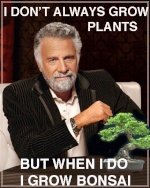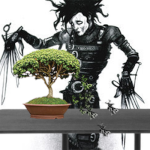Fertilizing question
+6
drgonzo
Sam Ogranaja
Billy M. Rhodes
Nemphis
JimLewis
Poink88
10 posters
Page 2 of 2
Page 2 of 2 •  1, 2
1, 2
 Re: Fertilizing question
Re: Fertilizing question
JimLewis wrote:
You probably will end up straining most of it. Your soil particles should be no smaller than 1/8 inch. River sand, unless you are in the mountains or higher foothills, tends to be smaller -- more suitable for kids' sandboxes or for making concrete.
I'll give it a try,as soon as possible.
Now the snow is half a meter.

Nemphis- Member
 Re: Fertilizing question
Re: Fertilizing question
I have just contacted Scotts as I'm curious as to whether Osmocote does indeed have an effective "safe" temperature range or if this problem with sudden release has been fixed. Many reputable Bonsai growers including some very well known names, use time release granules either on soil surface or in their fertilizer balls and I am investigating these products for possible use.
I'll let you know what Osmocote says.
-Jay
I'll let you know what Osmocote says.
-Jay

drgonzo- Member
 Re: Fertilizing question
Re: Fertilizing question
this got me thinking - if i had absolutely no money what so ever what soil would i use for bonsai that was totally free??
I think geographically around here i would be visiting the waste piles of the quarries with my sieves - i would easily get various grit particles, especially granite. The rivers and streams are great at sorting out particle sizes too - faster water has bigger bits, calm water has finer stuff, so i would be sieving some streams for 4-8mm particles. Pine needle litter is excelent - the carpet of needles and bark fragments in the dark areas under forestry plantations would be visited for sure, scrape the top layer off and collect the layer that is starting to break down . Sphagnum moss is a very good additive too - fresh and finely chopped.
i think many of my trees would do pretty well too. Makes you wonder sometimes....
cheers Marcus
I think geographically around here i would be visiting the waste piles of the quarries with my sieves - i would easily get various grit particles, especially granite. The rivers and streams are great at sorting out particle sizes too - faster water has bigger bits, calm water has finer stuff, so i would be sieving some streams for 4-8mm particles. Pine needle litter is excelent - the carpet of needles and bark fragments in the dark areas under forestry plantations would be visited for sure, scrape the top layer off and collect the layer that is starting to break down . Sphagnum moss is a very good additive too - fresh and finely chopped.
i think many of my trees would do pretty well too. Makes you wonder sometimes....
cheers Marcus

marcus watts- Member
 organic
organic
I have raked a thousand leaves and put them in a hole I dug. Get some lime sprinkle in a cup. then add all uneaten foods and you get a dark rich soil that works like magic.

ShrekMG- Member
 Re: Fertilizing question
Re: Fertilizing question
I have used a time release called Dynamite which is supposedly formulated to avoid this problem.drgonzo wrote:I have just contacted Scotts as I'm curious as to whether Osmocote does indeed have an effective "safe" temperature range or if this problem with sudden release has been fixed. Many reputable Bonsai growers including some very well known names, use time release granules either on soil surface or in their fertilizer balls and I am investigating these products for possible use.
I'll let you know what Osmocote says.
-Jay
FrankP999- Member
 Re: Fertilizing question
Re: Fertilizing question
Nemphis wrote:
Well,I'm living next to a river,it's not even 1km to it,and on this river they are extracting gravel and sand.
Wouldn't that help?
Have you seen our trees?
Actually 100% of my trees are planted in river sand, with some mixture of course gravel or volcanic cinder at the bottom for faster drainage purposes specially when roots became tightly bounded. Most of the Philippine trees posted here are planted in river sand too. River sand got natural fertilizer on them, doesn't become clay, doesn't hold water, doesn't decay. Some trees we put crushed seashells or clams at the pot bottom.
regards,
jun
Guest- Guest
 Re: Fertilizing question
Re: Fertilizing question
I picked up an Acacia forest at the Expo a couple weekends back and Hank Miller has it planted in smooth grey gravel, like aquarium stone..the thing is thriving!
Its a soil not far off from what I would find if I started sifting the bedding stone of the seasonal crick behind my house.
-Jay
Its a soil not far off from what I would find if I started sifting the bedding stone of the seasonal crick behind my house.
-Jay

drgonzo- Member
 Re: Fertilizing question
Re: Fertilizing question
Jun, Do you sift the river sand or use it as-is?jun wrote:Actually 100% of my trees are planted in river sand, with some mixture of course gravel or volcanic cinder at the bottom for faster drainage purposes specially when roots became tightly bounded. Most of the Philippine trees posted here are planted in river sand too. River sand got natural fertilizer on them, doesn't become clay, doesn't hold water, doesn't decay. Some trees we put crushed seashells or clams at the pot bottom.

Poink88- Member
 Re: Fertilizing question
Re: Fertilizing question
It's really interesting to hear about making bonsai soil from natural (and free) things. But I was also really interested to hear people's responses to the original topic too. I too would like to hear about everyone's feeding rituals, from the super simple to the more complex ones.

Mr. Carter- Member
 Re: Fertilizing question
Re: Fertilizing question
Well, Mr. C., I think if you read through this thread and then do a search (see the home page) for other Fertilizer threads, you will quickly see that lots and lots is said about fertilizer and we all feel strongly about something, but NOTHING has ever been decided. Maybe we won't need to go through it all over again>>????????

JimLewis- Member
 Re: Fertilizing question
Re: Fertilizing question
Yikes. Is fertilizer a touchy subject, like soil mixes? If that's the case, I won't wake the beast.

Mr. Carter- Member
 Re: Fertilizing question
Re: Fertilizing question
I have received an "answer" from Scotts in response to my e-mail about Osmocote.
I asked;
1. is there a safe temperature range at which the product can be used.
2. What is the dilution rate of the fertilizer when water passes over the granules.
This is the almost embarrassing 'Copy/Paste' sales pitch/PR response I received.
"Osmocote is the Smart Plant Food - it works on the principle of osmosis, which is how the product gets its name. Osmocote prills absorb moisture from the soil, causing them to swell into plump capsules of liquefied plant food. The nutrients are then slowly released through the prill's special coating to the plant's root zone through osmosis. This constant supply of nutrients promotes more beautiful plants. And because the nutrients are encapsulated, they will not wash away - no matter how much it rains or how often your garden is watered.
When the soil is warm plants need more nutrients and Osmocote will release at a slightly faster rate. When the soil is colder, it releases more slowly, as fewer nutrients are needed for plant growth and development. When used as directed, Osmocote will provide a constant supply of nutrients to your plants for 4 months in soil with an average temperature of 70 degrees."
Looks like its still temperature dependent and whats the release rate ? your guess is as good as mine. I'm trying out Osmocote Plus (which is Urea free) on the trees in development as they use a ton of Dyna-grow and I would prefer to give them a steady fertilizer rather than a 'once every week' dosage. As for the nicer specimens in my collection, for now, I'll stick with my Dyna until this stuff proves itself to me.
I like to experiment on the disposables first.
-Jay
I asked;
1. is there a safe temperature range at which the product can be used.
2. What is the dilution rate of the fertilizer when water passes over the granules.
This is the almost embarrassing 'Copy/Paste' sales pitch/PR response I received.
"Osmocote is the Smart Plant Food - it works on the principle of osmosis, which is how the product gets its name. Osmocote prills absorb moisture from the soil, causing them to swell into plump capsules of liquefied plant food. The nutrients are then slowly released through the prill's special coating to the plant's root zone through osmosis. This constant supply of nutrients promotes more beautiful plants. And because the nutrients are encapsulated, they will not wash away - no matter how much it rains or how often your garden is watered.
When the soil is warm plants need more nutrients and Osmocote will release at a slightly faster rate. When the soil is colder, it releases more slowly, as fewer nutrients are needed for plant growth and development. When used as directed, Osmocote will provide a constant supply of nutrients to your plants for 4 months in soil with an average temperature of 70 degrees."
Looks like its still temperature dependent and whats the release rate ? your guess is as good as mine. I'm trying out Osmocote Plus (which is Urea free) on the trees in development as they use a ton of Dyna-grow and I would prefer to give them a steady fertilizer rather than a 'once every week' dosage. As for the nicer specimens in my collection, for now, I'll stick with my Dyna until this stuff proves itself to me.
I like to experiment on the disposables first.
-Jay

drgonzo- Member
 Re: Fertilizing question
Re: Fertilizing question
I buy from a wholesaler in Apopka, FL named BWI, they sell a lot of Osmocote, but the only Osmocote they had with trace elements also had high nitrogen, but they have a balanced product with minors called Multicote and I use that on everything.

Billy M. Rhodes- Member
Page 2 of 2 •  1, 2
1, 2
 Similar topics
Similar topics» Have I over fertilised my bonsai?
» Fertilizing
» Should I keep fertilizing?
» Best hose end sprayer for fertilizing.
» Fertilizing junipers
» Fertilizing
» Should I keep fertilizing?
» Best hose end sprayer for fertilizing.
» Fertilizing junipers
Page 2 of 2
Permissions in this forum:
You cannot reply to topics in this forum






